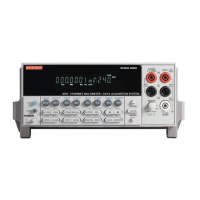Model 2701 User’s Manual Range, Digits, Rate, Bandwidth, and Filter 4-5
Manual ranging
The range is selected by specifying the expected reading as an absolute value using the
<n> parameter for the appropriate :RANGe command. The Model 2701 will then go to the
most sensitive range for that expected reading. For example, if you expect a reading of
approximately 3V, let the parameter (<n>) equal 3 to select the 10V range.
Auto ranging
The :RANGe:AUTO command is coupled to the command to select range manually
(:RANGe <n>). When auto range is enabled, the parameter value for :RANGe <n>
changes to the automatically selected range value. When auto range is disabled, the
instrument remains at the selected range. When a valid :RANGe <n> command is sent,
auto ranging disables.
Range programming examples
NOTE The following examples can be run from the KE2700 Instrument Driver using
the example named “MultiRange” in Table G-1 of Appendix G.
Example #1 — The following commands select range for DCV, Ω2, and DCI:
VOLT:RANG 0.5 ' Select 1V range for DCV.
RES:RANG 2e3 ' Select 10kΩ range for Ω2.
CURR:RANG 0.1 ' Select 100mA range for DCI.
Example #2 — The following command sequence configures channel 101 of the
Model 7700 to select the 10VDC range when it is scanned.
FUNC 'VOLT',(@101) ' Set 101 for DCV function.
VOLT:RANG 1.5,(@101) ' Set 101 for 10V range.

